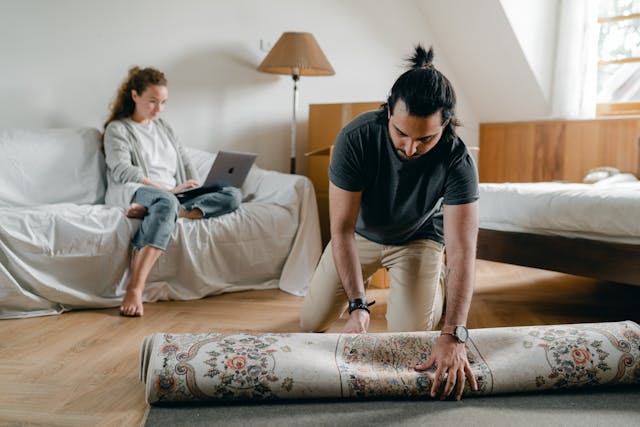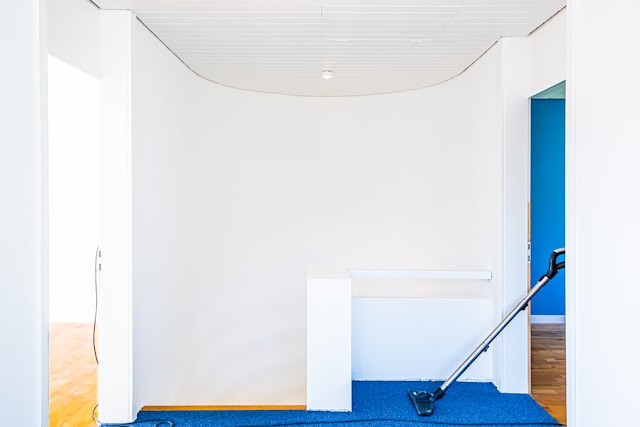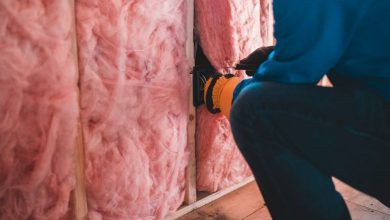Cleaning Different Types of Carpet

Carpets are a beautiful and functional addition to any home, adding warmth, texture, and comfort to your living space. However, with regular foot traffic, spills, and everyday dirt, carpets can quickly start to look worn and stained if they’re not cared for properly. The challenge is that not all carpets are created equal. From plush wool rugs to durable nylon fibers, different types of carpets require unique cleaning techniques to stay in top shape. Using the wrong method on the wrong carpet can lead to damage, discoloration, or a shortened lifespan. In this guide, we’ll dive into the best cleaning practices for various types of carpets, helping you keep them looking fresh and new for years to come.
1. Cleaning Different Types of Carpet
Cleaning carpets isn’t as straightforward as it may seem. Each type of carpet, whether it’s a luxurious wool rug or a sturdy nylon floor covering, needs to be handled differently to maintain its look and durability. Choosing the wrong cleaning method or products can result in irreversible damage, such as fiber degradation, shrinkage, or color fading. Understanding how to clean your specific carpet type will save you time, effort, and money while extending the life of your carpet.
Carpets are generally categorized into natural and synthetic fibers. Wool, silk, and cotton fall under natural fibers, offering a luxurious feel but requiring more delicate care. On the other hand, synthetic carpets like nylon, polyester, and olefin are more durable and easier to clean. However, they can still attract certain types of dirt and oils that need special attention. Knowing the right techniques and tools for each carpet type will ensure a cleaner, fresher-looking home.
2. Understanding Carpet Fibers
Carpet fibers are what give your carpet its texture, durability, and overall feel. These fibers can be broadly classified into two types: natural and synthetic. The type of fiber plays a huge role in determining how you should clean and maintain your carpet.
Natural vs. Synthetic Fibers
Natural fibers like wool, silk, and cotton are more delicate and can easily be damaged by aggressive cleaning methods. They are prone to shrinking, staining, and fading, especially if exposed to too much moisture or harsh chemicals. On the other hand, synthetic fibers such as nylon, polyester, and olefin are much more resistant to stains and wear, making them easier to clean and maintain. Synthetic carpets are also more budget-friendly, but they can be more prone to trapping oils and dirt.
Understanding whether your carpet is made of natural or synthetic fibers is the first step toward determining the best cleaning method. While natural carpets may require more gentle, eco-friendly cleaning solutions, synthetic ones can handle stronger chemicals and deeper cleaning techniques.
Common Carpet Fiber Types and Their Characteristics
Wool is a popular natural fiber due to its softness and eco-friendliness. It is naturally resistant to soiling but is highly sensitive to moisture, which can cause shrinking. Nylon, on the other hand, is one of the most durable and resilient synthetic fibers. It resists crushing and is ideal for high-traffic areas but can attract oil-based stains. Polyester is stain-resistant and holds vibrant colors well, though it tends to wear down in high-traffic areas. Olefin is moisture-resistant and budget-friendly but can flatten quickly with heavy use.
3. How to Clean Wool Carpets
Wool carpets are elegant, eco-friendly, and durable, but they require special care to maintain their luxurious texture and look. Since wool is a natural fiber, it’s more sensitive to moisture, chemicals, and rough handling.
The Do’s and Don’ts of Wool Carpet Care
When cleaning wool carpets, always avoid harsh chemicals or detergents that are too strong, as these can damage the fibers. Excessive moisture can lead to shrinking or mildew, so over-wetting should be avoided at all costs. Stick to gentle cleaning solutions, and always blot spills instead of rubbing them, which can drive the stain deeper into the fibers. Also, when vacuuming wool, use a vacuum without a beater bar to prevent fraying or damage to the delicate fibers.
Safe Cleaning Solutions for Wool Carpets
For regular cleaning, a solution of water and white vinegar can be an effective and safe method for removing stains on wool carpets. Additionally, wool-specific detergents are available that are formulated to clean while protecting the fibers. Regular vacuuming is crucial for wool carpets to keep them looking fresh, but deep cleaning should be done cautiously to prevent damage.

4. How to Clean Nylon Carpets
Nylon is one of the most durable synthetic carpet fibers, making it a popular choice for high-traffic areas. However, it still requires regular cleaning to prevent dirt buildup and to keep its appearance vibrant and fresh.
Best Practices for Spot Cleaning Nylon Carpets
Nylon is generally more stain-resistant than other fibers, but it’s still essential to treat stains quickly. For spot cleaning, always blot spills rather than scrubbing, as scrubbing can force the dirt deeper into the fibers. Use a mild carpet cleaner that’s safe for synthetics or a mixture of warm water and a few drops of dish soap. After cleaning, rinse the area with clean water and blot dry.
Deep Cleaning Methods for Nylon Carpets
For a deep clean, steam cleaning or using a carpet shampooer is effective on nylon carpets. The heat and moisture work to break down dirt embedded deep in the fibers, and nylon is resilient enough to handle the process without damage. Just ensure the carpet is thoroughly dried after cleaning to prevent mold or mildew.
5. How to Clean Berber Carpets
Berber carpets are known for their tightly looped fibers, which make them durable but also more prone to holding onto dirt and stains. They require special cleaning methods to avoid damaging the loops.
Avoiding Common Mistakes with Berber Carpet Care
One of the biggest mistakes people make when cleaning Berber carpets is scrubbing too hard. This can cause the loops to fray or unravel, damaging the carpet’s appearance. Gentle blotting is always preferred, especially when dealing with stains. Be sure to use a cleaner that is safe for Berber, as harsher chemicals can damage the fibers.
Choosing the Right Tools for Cleaning Berber Carpets
When vacuuming Berber carpets, it’s crucial to use a vacuum without a rotating brush or beater bar, as these can pull at the loops and cause damage. Instead, use a vacuum with strong suction to remove dirt from between the loops. For deep cleaning, professional steam cleaning is the best option to preserve the integrity of the carpet.
6. How to Clean Shag Carpets
Shag carpets have long, thick fibers that provide a soft, luxurious feel but can be a magnet for dirt, dust, and debris. Proper cleaning methods are essential to maintain their appearance.
Maintaining Shag Carpets to Prevent Matting
Shag carpets are prone to matting, especially in high-traffic areas. Regular vacuuming with a handheld attachment can help fluff up the fibers and remove surface dirt. It’s also a good idea to periodically shake out the carpet to remove debris trapped deep within the fibers. Never use a beater bar, as this can tangle and damage the long fibers.
Cleaning Deep into Shag Carpet Fibers
For deeper cleaning, sprinkle baking soda on the shag carpet and leave it for about 15 minutes before vacuuming it up. This helps neutralize odors and loosen dirt trapped in the fibers. For tough stains, use a mild carpet cleaner or hire a professional for a thorough steam cleaning.

7. How to Clean Polyester Carpets
Polyester carpets are budget-friendly and naturally stain-resistant, making them a popular choice for homes with children and pets. However, they still need regular maintenance to avoid becoming dull or dingy.
Dealing with Stains on Polyester Carpets
Polyester repels liquids better than most other fibers, but spills should still be cleaned up promptly. Use a gentle carpet cleaner designed for synthetic fibers or a solution of water and dish soap. Always blot the stain instead of rubbing, as rubbing can spread the stain and push it deeper into the fibers.
Maintaining Polyester’s Appearance Over Time
To keep polyester carpets looking their best, vacuum regularly to prevent dirt from embedding in the fibers. Deep cleaning with a steam cleaner or carpet shampooer every 12 to 18 months will help restore its appearance and remove any deeply embedded dirt or grime.
8. Conclusion
Different carpets require different cleaning approaches to maintain their beauty and longevity. Wool, nylon, polyester, Berber, and shag carpets each have their unique qualities and challenges when it comes to cleaning. Understanding the specific needs of your carpet will help you keep it clean without causing damage. Regular maintenance, combined with occasional deep cleaning, will ensure that your carpets remain fresh and vibrant for years to come.
9. FAQ (Frequently Asked Questions)
-
How often should I vacuum my carpet?
High-traffic areas should be vacuumed daily, while less-used areas can be vacuumed at least once a week to prevent dirt buildup. -
Can I use the same cleaner for all types of carpets?
No, different carpet fibers react differently to various cleaning solutions. Wool needs gentle cleaners, while synthetic carpets like nylon can tolerate stronger products. -
Is steam cleaning safe for all carpets?
Steam cleaning is safe for most synthetic carpets but should be used sparingly on wool, as too much moisture can damage natural fibers. -
What’s the best way to remove pet odors from carpets?
Baking soda is excellent for neutralizing odors. Sprinkle it on the carpet, leave it for a few hours, then vacuum it up. For stronger odors, enzyme-based cleaners work well. -
How can I prevent my carpet from fading?
To prevent fading, avoid direct sunlight exposure. Use curtains or blinds during the brightest part of the day and clean your carpets regularly to maintain their original color. -
Should I hire a professional to clean my carpet?
Yes, for deep cleaning or difficult stains, hiring a professional is often the best option. They have the right equipment and expertise to safely clean all types of carpets. -
How do I get rid of tough stains like wine or coffee?
Blot the stain immediately with a clean cloth. Then use a mixture of water, vinegar, and dish soap to lift the stain. For particularly stubborn stains, you might need a professional cleaner.




